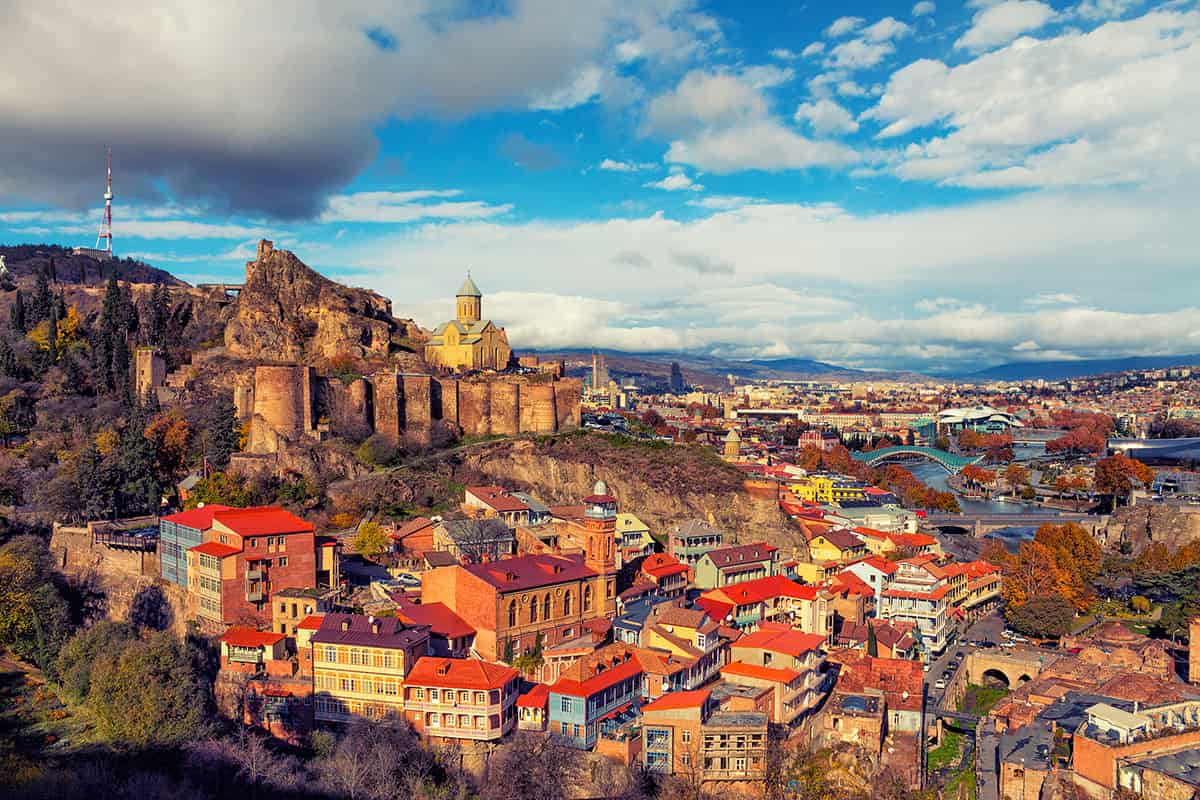Geopolitics and the Russia-Ukraine war are highlighting the potential of Georgia and Armenia’s expanding economies.
Tbilisi, Georgia, will host the Asian Development Bank’s (ADB) annual meeting the first week of May. Soon thereafter, the European Bank for Reconstruction and Development’s (EBRD) confab takes place in Yerevan, Armenia. The near-convergence of two heavyweight multilaterals comes as the two countries exhibit strong economic growth accompanied by growing excitement about the middle corridor, an Asian-European supply chain route connecting the Caspian Sea through Azerbaijan with the Black Sea through Georgia.
Despite persistent geopolitical storms, often related to neighbors Russia and Turkey, both Caucasian nations are on the upsurge. Armenia enjoyed GDP growth of 12.6% in 2022 and 7% last year, with International Monetary Fund (IMF) predicting a further 5% jump this year. The respective figures for Georgia are 10.1%, 6.2%, and 4.8%.
Credit goes partly to the post-Covid rebound, notably in tourism, and solid fundamentals, including better control of the public debt in Georgia and a stronger external balance sheet in Armenia.
[UPDATE: May 15 — Less than two weeks after the Asian Development Bank annual meeting in Tbilisi, Georgian lawmakers passed a bill in an 84-30 vote, aimed at limiting the influence of foreign-funded non-governmental organizations (NGOs) and media. The vote came amid massive protests, where the opposition claims that the bill is an authoritarian overreach. Analysts predicted that the move could stifle anti-corruption efforts and jeopardize the country’s candidacy to join the European Union. The legislation would require NGOs and media outlets that receive more than 20% of their funding from abroad to register with the government as “foreign agents.”]
But a few contributing factors may seem counterintuitive.
Georgia and Armenia “are somewhat unexpected beneficiaries of the fallout of the of the war in Ukraine,” Jan Friederich, head of EMEA Sovereign Ratings at Fitch Ratings, said during a public online event hosted by the agency, “primarily in terms of the large number of migrants and the large amount of capital that they have attracted, which in turn has improved a lot of credit metrics.”
Reliable numbers are hard to track down, but analysts generally agree that a huge influx of migrants from Russia, Ukraine and Belarus have arrived in both countries since Russian President Vladamir Putin escalated attacks on Ukraine in February 2022.
Up to 100,000 Russians have since entered Armenia, according to different estimates cited by the Italian Institute for International Political Studies (ISPI) in Milan. As of October, up to 60,000 Russians remained. Along with them, capital transfers from Russia jumped to 37.4% of GDP in 2022, up from 15.2% in 2021, according to the ADB.
By the end of 2022, about 110,000 Russians had moved to Georgia, according to a press reports citing figures from Georgia’s Interior Ministry. Since then, outflows of returnees or people moving to third countries have outdistanced inflows, with a net decline of 31,000 last year. During the first half of 2023, remittances from Russia to Georgia increased by 50%, totaling $1.1 billion, according to Transparency International Georgia (TIG), an anti-corruption non-governmental organization.
Most of the immigrants “are quite affluent compared to living standards in Georgia,” says Dimitar Bogov, regional lead economist for Eastern Europe and Caucasus at the EBRD. “Their purchasing power is important.” While this has led to overheating in the Tbilisi real estate market and the expected resentment from locals, the economic effect has been positive, by and large.
“Local financial institutions have much benefited from stronger revenue generation and larger business volumes,” says Artem Beketov, director of EMEA bank ratings at Fitch. Banks in the two countries “also earned extra-large revenue and received additional liquidity related to immigration and money flows from Russia.”
While still significant, remittances appear to be dwindling. Meanwhile, many of the predominately upscale and well-educated newcomers shows signs of putting down roots and investing in the local economies: 21,326 companies were registered in Georgia by Russian immigrants between the start of the war and September, according to TIG.
Emphasis On IT
Information technology is the main driver of Armenia’s economic upsurge. The landlocked country emphasized IT and other service industries after the collapse of the Soviet Union, and the influx of foreign—especially Russian—coders and other IT professionals has helped fill a labor shortage in the sector due to brain-drain emigration to the rest of the world.
Russian companies that have expanded operations in Armenia include Miro, an online whiteboard tool valued in the billions, and the tech giant Yandex.
“One of the unexpected consequences of the war was that IT companies and IT experts went to Armenia,” says Bogov. “This was substantial for a small economy.”
New or relocated migrant-owned businesses “represent investment and boost GDP,” says Arvind Ramakrishnan, director of sovereign ratings at Fitch. “It also gives us more confidence that these people are here to stay, at least for the medium term.”
Armenia also received over 100,000 refugees who fled Nagorno-Karabakh when Azerbaijan took full control of that predominately ethnic-Armenian enclave in September, according to the International Crisis Group in Brussels. Most of these individuals were either farmers or public sector bureaucrats, Bogov notes.

purchasing power of ex-patriate migrants
are significant
Short-term public support for these newcomers has further boosted economic activity, but the jury remains out on their ultimate impact. “Concerning their skills, there may be an issue ahead,” says Bogov. “It depends on how integrated they become in the Armenian economy and society.”
The Middle Corridor Beckons
Both Armenia and Georgia have enacted policies to promote sustainable development and green growth, a report by the Organization for Economic Co-operation and Development (OECD) notes. Georgia has adopted WHEN? a new law on environmental liability, and both countries are working with the European Union to adopt better standards.
Georgia applied for EU membership in 2022, and an accession process is under way, but most close observers expect it to be drawn out. A shorter route to international economic integration, some analysts say, might be the Middle Corridor, known more formally as the Trans-Caspian International Transport Route and less formally as the Silk Road, a multimodal supply-chain route coming together between China and Central Asia and Europe. Given current geopolitics, it also offers an attractive alternative to the Northern Corridor, which runs through Russia and Belarus.
The Middle Corridor needs Georgia for its access to the Black Sea, which offers an end point for goods that travel by rail from Central Asia to the Caspian Sea, then by ship to Azerbaijan, then to Georgia by rail, before the final leg from Georgia to Europe by ship. While complicated logistically and bureaucratically, the Middle Corridor route has the benefit of being currently undisturbed by either war or economic sanctions.
Despite the bottlenecks, container traffic along the Middle Corridor grew by 33% year-on-year in 2022, according to the International Institute for Strategic Studies (IISS), a London-based global think tank. Companies in Sweden such as Ikea, Tetra Pak, and Volvo need a reliable, lower-cost supply-chain route from Asia, says Jean-Paul Larçon, emeritus professor of Strategy and International Business at HEC Paris business school. Air flight is faster but more expensive; shipping through the Suez Canal takes 40 days and carries security risks, given Houthi attacks on shipping; and traveling around the Horn of Africa takes 50 days. The Northern Corridor is also vulnerable to geopolitical and security risks.
That makes the Middle Corridor “an incredible opportunity” for the countries along the way, including Georgia, Larçon argues.
The EBRD has already invested in Georgia’s transportation infrastructure, and the future of the Middle Corridor looks bright, he adds, with projections that at least 10% of Asian-European trade could be using the route in the near future.
“If you are Georgia, why not invest in that?” he says.




